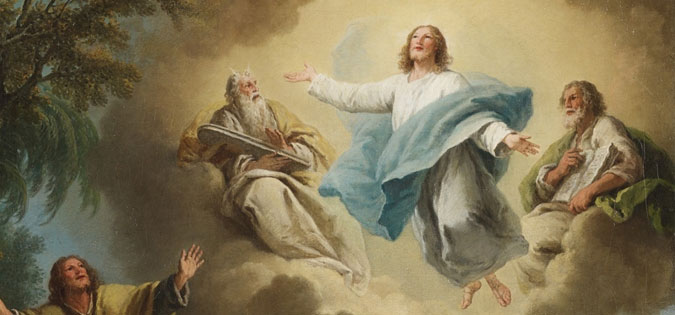 Each week of Lent, we’ll provide an Ignatian prayer for you, inspired by a video from Arts & Faith: Lent. The video and prayer for the Second Week of Lent, Cycle B, are based on Mark 9:2–10. The art is Francesco Zuccarelli’s “Landscape with the Transfiguration of Christ.”“Jesus took with him Peter and James and John, and led them up a high mountain apart, by themselves. And he was transfigured before them.”
Each week of Lent, we’ll provide an Ignatian prayer for you, inspired by a video from Arts & Faith: Lent. The video and prayer for the Second Week of Lent, Cycle B, are based on Mark 9:2–10. The art is Francesco Zuccarelli’s “Landscape with the Transfiguration of Christ.”“Jesus took with him Peter and James and John, and led them up a high mountain apart, by themselves. And he was transfigured before them.”
—Mark 9:2
Preparation
The union in openness of body and mind and heart that is prayer begins with attention to each.
First your body: Sit upright, legs crossed or not, feet on the floor or not, lower back pressed against the chair. Or not. Breathe.
Now the mind: As you are able, let these words spill through the mind and down your spine into the earth. Let your thoughts puff away with each breath. As new ones come—knotted as they are with joy or pain—hold them like wounded birds. Set them aside to heal. Breathe.
And the heart: Vulnerability means able to be wounded. Of course there is resistance. Notice it. With your breath and with energy, pull back the vines and push open your heartgate. Breathe.
Tilt your chin up to the heavens and, with eyes open or closed, look back at the One who looks at you with great affection.
Breathe.
Postures of Prayer
Strange as it might seem to say, in the Transfiguration nothing changed for Jesus. In that moment of revelation he lived the same unity with the Father and the Spirit as he always had. What changed was that, for a moment, Peter and James and John could see him as he was and always is.
Their hands tell the story of their reactions. As you pray these next minutes, let your hands imitate theirs. Let their postures be your prayer.
With Peter lean forward, close your eyes and turn your face. Reach out toward your friend, toward the light.
- How do you feel in this position of submission, of pleading?
- What is the light like on your hands, your cheek, your back? Does it penetrate your closed eyes?
- How does Jesus react to your outstretched hands? Does he grasp them? Lift you up?
With John cross your hands over your chest, tilt your chin and look away.
- How do you feel in such a posture?
- Are you holding something close with gentle affection? What are you holding? What comes to your memory?
- Or are your hands guarding your heart? Do you feel vulnerable?
- How does Jesus react to your hands, your stance? Does he come closer? Do you want him to?
With James raise your arms, open your palms, arch your back, and lift your eyes.
- How does it feel for your body to be so opened before the Lord?
- What stirs, what emerges from within as the light falls through your fingers, onto your face?
- Were you ready for this revelation? Is there anything you want to say?
There are many ways to say yes. There are many ways to accept what is offered. In Jesus’ Transfiguration we are given a glimpse of what will happen to us when we approach, as closely as we can, the constant consent, the steady yes, that Jesus and the Father give to one another.
Consent. It is consent that is requested of us. And this cannot be coerced.
- How do you feel that the Lord refuses to coerce you?
- What is it like to be invited into this unity?
- Is there anything you want to say to the Lord?
Speak with the Lord now about what has happened. Speak with him as one friend speaks to another.
Concluding Prayer
Glory be to the Father,
and to the Son,
and to the Holy Spirit.
As it was in the beginning,
is now, and ever shall be,
world without end.
Amen.

What about the horns? Scholars believe this was a mistranslation of Hebrew scriptures into Latin by St. Jerome, called the Vulgate. It was the Latin translation of the Bible used at that time. Moses is described as having “rays of the skin of his face.” Jerome translated it to horns from the word keren, which means either radiated or grew horns.
Horns were a symbol of wisdom and rulership in ancient times
I love this meditation, but I’ve always had a question about how Moses is pictured. His hair has two points. What does that symbolize? It almost looks like horns, but I wondered what the artist was thinking with that? Is there an explanation of that?
I prayed with this imaginative prayer exercise, and I was given a new variation on the traditional way of making the “Sign of the Cross”: Peter’s posture shows us how to address the Father (a name so holy that we cannot say it in any way but in our bowed silence); John’s posture shows how we can address the Son (we cross our heart in love for Jesus); and James’ posture shows how we reach outward and upward asking to receive the Holy Spirit (as Jesus recommended in Luke 11:13).